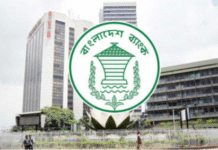Private sector credit growth plunges to single digit in November

The private sector credit growth dropped to single digit in November, continuing the recent falling trend.
But there is no shortage of money supply in the banking system and the lending rates of most banks are lower than those at any time in the past.
Slow export-import businesses and banks’ cautious lending amid the pressure of implementing a single-digit interest rate are causing a slump in the private sector credit growth.
Year-on-year credit growth dipped to 9.87 percent in November, breaking the previous month’s lowest rate of 10 percent in recent history.
The growth rate was far below the central bank’s target of 13.20 percent for up to December.

However, public sector credit growth more than doubled the monetary policy target in November, reflecting that the economy is growing, riding on public sector investment.
High bank borrowing amid low revenue earning is also blamed for squeezing private sector credit growth, industry experts commented.
“It is concerning that private sector credit growth came down to single digit,” said Fahmida Khatun, executive director of the Centre for Policy Dialogue.
The current level of private sector credit growth is not enough for retaining the current pace of economic growth, she maintained.
She suggested that the government look deep into why the private sector credit growth is falling.
The major boost to GDP growth came from the private sector, Fahmida said, adding the fall in private sector credit growth reflects a dip in private investment which is worrying.
Though the high interest rate is blamed for slow credit growth, it is not the only indicator to boost investment. There are other factors such as infrastructural facilities and investors’ confidence that could encourage private sector investment, Fahmida said.
The global economic slowdown impacted import-export businesses, causing a slump in credit demand, said AK Azad, managing director of Ha-Meem Group.
“Bangladesh’s major export competitors including India and Pakistan substantially devalued their currencies, capturing our market,” he said.
As a result, the overall export dropped when these competitors saw a rise, Azad explained.
The possibility of improvement in private sector credit growth next year is very slim, said Syed Mahbubur Rahman, managing director of Mutual Trust Bank, explaining that the pressure of keeping the lending rate at single digit will make the banks reluctant to disburse loans.
Also, high government borrowing from the banking system will hurt money flow to the private sector, Azad feared.
Though the government wants the economy to grow at 8.2 percent in the current fiscal year, different multinational agencies have cast doubt over it.
Fitch, the global rating agency, recently projected that Bangladesh’s economic growth will roll back to 7.5 percent in FY20 and 7.2 percent in FY21.
Less dependence on part of the government on national saving certificates may crowd out private-sector borrowing, according to Fitch.
Bangladesh achieved 8.13 percent growth in fiscal year 2018-19.
A move to enforce the single-digit interest rate from January 1 has prompted commercial banks to go cautious on lending and to tighten scrutiny of loan proposals, said bank insiders.
Though the move is intended at facilitating industrialisation, cutting the cost of business, it has produced opposite results as the banks shifted their lending focus to unproductive sectors from manufacturing.
The banks’ reluctance to lend to productive sectors is already apparent, with the April-June credit growth to the industrial sector slowing down to 10.39 percent from 46.46 percent in the same period last year.
However, loan growth in unproductive sectors saw a leap thanks to the absence of any fixed lending rates. For instance, consumer loan growth surged to 8.71 percent during the April-June quarter, which was less than 1 percent in the same period last year, according to the central bank data.
In November 2017, private sector credit growth rose to a peak of 19 percent due to aggressive lending by banks.
The abnormal rise in credit growth prompted Bangladesh Bank to control it by cutting down the advance deposit ratio last year. The central bank’s strong move slowed down credit flow to the private sector, continuing throughout last year.
To cut default loans, Finance Minister AHM Mustafa Kamal, soon after taking charge in January this year, pressured the commercial banks to implement the single-digit interest rate.
The pressure of implementing the single-digit lending rate impelled the banks to slack up the disbursement of loans, causing a record fall in private sector credit growth to 10 percent in October.
The slow credit growth piled up excess liquidity in the banking system.
Just a year back, banks went through a crunch period, with little money to lend. But now they have a total of Tk90,000 crore in their the vaults.









